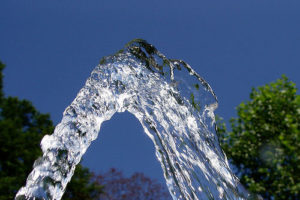Multiple factors influence watering needs. Established trees will generally require less water than newly planted trees. New trees’ root systems are less established, so they require careful watering during the first one or two years. Plant placement is also important. Buildings, walls, and fences can reflect heat, putting plants at risk of damage. These areas will need more water, as will windy zones.
Soil composition matters, too. Sandy soils drain quickly and therefore need more frequent watering. Clay-heavy soils tend to hold onto moisture longer, so they can be irrigated less frequently. Tree care will also vary by species. Water-hungry trees naturally grow along streams and rivers; species from arid region plants will survive far drier conditions.

General Watering Tips:
— Water at the Drip Line. Large, established trees have a root spread as wide as the tree is tall. Water the most critical part of the root system by soaking the area beneath the drip line.
—Slower is better. Trees can best soak up water when it is distributed slowly to a depth of 12 inches. Slow watering allows for best absorption. Irrigation lines are ideal for this style of watering. A good rule of thumb for each watering session is to slowly distribute 5 to 10 gallons of water for every inch in the tree’s diameter.
—Avoid soaking right around the tree’s trunk. Doing so can increase the chance of disease, fungal infestation in particular. Instead, focus on watering the area underneath and beyond the tree’s canopy. (Young trees are an exception to this rule; their roots will only occupy the planting hole area right around the trunk.)
—Be generous with damaged roots. Root systems that have been damaged will require more water for repair.
—Mulch for protection. Lay down a blanket mulch to a depth of three or four inches beneath the drip line. This will conserve moisture and offer some protection against cold. Leave the space right around the trunk free of mulch.
—Avoid extended soil saturation. Too much water can smother developing roots. If the underlying soil is soggy, hold off on watering. You can use a soil probe to determine soil moisture levels. A ¼” to 3/8” diameter rod will slide easily through moist soil, and become difficult to push into dry soil. You are looking for moisture at a depth of six inches below the soil surface.
—Water near the soil, not on foliage. Avoid spraying leaves with water. This can deposit salt and damage foliage. Overhead irrigation creates a disease-happy environment, where leaf spot diseases, mildew, fungus, and bacteria can take hold. Soaker hoses, standard hoses, and irrigation systems are the best water delivery systems.


